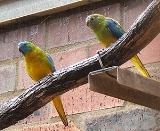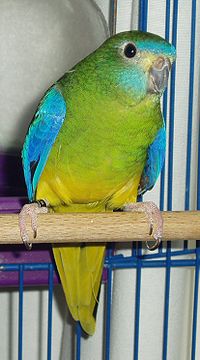
Turquoise Parrot
Encyclopedia
The Turquoise Parrot is a parrot
previously widespread in Eastern Australia
, though now mainly found in northeastern New South Wales
and north-eastern Victoria.
A small parrot at around 20 cm long, the male is predominantly green in colour and more yellowish below with a bright turquoise blue face and chestnut shoulders on the blue and green wings. Females are generally duller and paler and lack the chestnut wing patch.
It is found in grasslands and open woodlands, and feeds on grasses, seeds and nectar.
.
, it is listed as a Vulnerable species
under Schedule 2 of the New South Wales Threatened Species Conservation Act, 1995 because of Habitat Destruction
(TSC Act).
 Captive-bred birds adapt readily to aviary conditions, and the species is widely bred. Several colour forms are seen in captivity, including a yellow, red-fronted and pied form (all recessive), and jade and Olive (dominant).
Captive-bred birds adapt readily to aviary conditions, and the species is widely bred. Several colour forms are seen in captivity, including a yellow, red-fronted and pied form (all recessive), and jade and Olive (dominant).
Parrot
Parrots, also known as psittacines , are birds of the roughly 372 species in 86 genera that make up the order Psittaciformes, found in most tropical and subtropical regions. The order is subdivided into three families: the Psittacidae , the Cacatuidae and the Strigopidae...
previously widespread in Eastern Australia
Australia
Australia , officially the Commonwealth of Australia, is a country in the Southern Hemisphere comprising the mainland of the Australian continent, the island of Tasmania, and numerous smaller islands in the Indian and Pacific Oceans. It is the world's sixth-largest country by total area...
, though now mainly found in northeastern New South Wales
New South Wales
New South Wales is a state of :Australia, located in the east of the country. It is bordered by Queensland, Victoria and South Australia to the north, south and west respectively. To the east, the state is bordered by the Tasman Sea, which forms part of the Pacific Ocean. New South Wales...
and north-eastern Victoria.
A small parrot at around 20 cm long, the male is predominantly green in colour and more yellowish below with a bright turquoise blue face and chestnut shoulders on the blue and green wings. Females are generally duller and paler and lack the chestnut wing patch.
It is found in grasslands and open woodlands, and feeds on grasses, seeds and nectar.
Taxonomy and naming
The English Common Name of the Turquoise Parrot been known alternately as Chestnut-shouldered parakeet, Chestnut-shouldered grass-parakeet, Chestnut-shouldered Grass-parrot, Chestnut-winged Grass-parakeet, Chestnut-winged Grass-Parrot and Turquoisine Grass Parrot.Australia
It is not listed as threatened on the Commonwealth Environment Protection and Biodiversity Conservation Act 1999Environment Protection and Biodiversity Conservation Act 1999
The Environment Protection and Biodiversity Conservation Act 1999 is an Act of the Parliament of Australia that provides a framework for protection of the Australian environment, including its biodiversity and its natural and culturally significant places...
.
New South Wales
Once common in Western SydneySydney
Sydney is the most populous city in Australia and the state capital of New South Wales. Sydney is located on Australia's south-east coast of the Tasman Sea. As of June 2010, the greater metropolitan area had an approximate population of 4.6 million people...
, it is listed as a Vulnerable species
Vulnerable species
On 30 January 2010, the IUCN Red List of Threatened Species identified 9694 Vulnerable species, subspecies and varieties, stocks and sub-populations.-References:...
under Schedule 2 of the New South Wales Threatened Species Conservation Act, 1995 because of Habitat Destruction
Habitat destruction
Habitat destruction is the process in which natural habitat is rendered functionally unable to support the species present. In this process, the organisms that previously used the site are displaced or destroyed, reducing biodiversity. Habitat destruction by human activity mainly for the purpose of...
(TSC Act).
Victoria
- This species is listed as threatened on the Victorian Flora and Fauna Guarantee Act (1988).http://www.dse.vic.gov.au/DSE/nrenpa.nsf/LinkView/EADA0F1874AF9CF24A2567C1001020A388BBA5581CF9D859CA256BB300271BDB Under this Act, an Action Statement for the recovery and future management of the Turquoise Parrot has not been prepared.http://www.dse.vic.gov.au/DSE/nrenpa.nsf/LinkView/617768308BCB666E4A25684E00192281E7A24BB36FF60A144A256DEA00244294
- On the 2007 advisory list of threatened vertebrate fauna in Victoria, this species is listed as near threatenedNear ThreatenedNear Threatened is a conservation status assigned to species or lower taxa that may be considered threatened with extinction in the near future, although it does not currently qualify for the threatened status...
.
Aviculture


